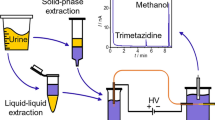Abstract
meso-2,3-Dimercaptosuccinic acid (meso-DMSA) is an effective chelating agent for the treatment of lead poisoning. We have developed a capillary electrophoresis (CE) method to monitor the urinary excretion of meso-DMSA in human beings. The urine sample was directly injected for analysis in CE without the requirement of solid-phase extraction (SPE). The meso-DMSA was detected in 20 mM borate buffer (pH 8.3) using a 60-cm length bare fused-silica capillary (75-μm ID, 52.5-cm effective length). The meso-DMSA can be extensively biotransformed during metabolism, and no meso-DMSA in urine samples was found in our studies. Any metabolized meso-DMSA can be successfully converted to free meso-DMSA by chemical reduction with dithiothreitol (DTT). In addition, samples were also treated with ethylenediaminetetraacetic acid (EDTA) to transchelate any meso-DMSA that is coordinated with metal ions present in the urine samples. The total amount of meso-DMSA present as these chemical forms was quantified after chemical reduction and addition of EDTA. The detection limit of meso-DMSA was about 50 μM, the RSD of peak area and migration time of meso-DMSA were 4–8% and less than 1%, respectively.



Similar content being viewed by others
References
Aposhian H (1983) Ann Rev Pharmacol Toxicol 23:193–215
Aaseth J (1983) Hum Toxicol 2:257–72
Graziano J, Leong J, Friedheim E (1978) J Pharmacol Exp Ther 206:696–700
Graziano J, Siris E, Loiacono N, Silvrerberg S, Turgeon L (1985) Clin Pharmacol Ther 37:431–8
Lever S, Parsons T (1999) Chem Res Toxicol 12:1057–65
Maiorino R, Barry T, Aposhian H (1987) Anal Biochem 160:217–26
Knudsen J, McGown E (1988) J Chromatogr-Biomed 424:231–41
Ellman G (1959) Arch Biochem Biophys 82:70–7
Ross A, Moore H, Ritter C, Moros S (1979) J Pharm Sci 68:657–8
Cifuentes A, Valencia J, Sanz E, Sanchez M, Rodriguez Delgado M (1997) J Chromatogr A 778:389–96
Sheppard R, Henion J (1997) Anal Chem 69:2901–7
Willetts M, Clarkson P, Cooke M (1996) Chromatographia 43:671–4
Veraart J, Lingeman H, Brinkman U (1999) J Chromatogr A 856:483–514
Lanz M, Thormann W (1996) Electrophoresis 17:1945–9
Taylor M, Westwood S, Perrett D (1996) J Chromatogr A 745:155–63
Sadecka J, Polonsky J (1996) J Chromatogr A 735:403–8
Bir K, Crawhall J, Mauldin D (1970) Clin Chim Acta 30:183–90
Zahler W, Cleland W (1968) J Biol Chem 243:716–9
Schwartz BS, Lee B-K, Lee G-S, Stewart WF, Lee S-S, Hwang K-Y, Ahn K-D, Kim Y-B, Bolla KI, Simon D, Parsons PJ, Todd AC (2001) Am J Epidemiol 153:453–464
Asiedu P, Moulton T, Blum CB, Roldan E, LoIacono NJ, Graziano JH (1995) Environ Health Perspect 103:734–739
Acknowledgments
We would like to thank Brian S. Schwartzof the Johns Hopkins University, Baltimore Maryland, USA and Byung-Kook Lee Institute of Industrial Medicine Soonchunhyang University Chonan, Republic of Korea for samples of urine. We would like to thank Drs Yong-Bae Kim, Kyu-Yoon Hwang, Sung-Soo Lee, and Kyu-Dong Ahn for assisting in data collection in Korea. This publication was made possible by grant number ES07933 (SZL) and ES07198 (BSS) from the United States National Institute of Environmental Health Sciences (NIEHS). Their contents are solely the responsibility of the authors and do not necessarily represent the official views of the NIEHS.
Author information
Authors and Affiliations
Corresponding author
Rights and permissions
About this article
Cite this article
Zhu, X., Lever, S.Z. Analysis of meso-2,3-dimercaptosuccinic acid in human urine by capillary electrophoresis using direct injection. Anal Bioanal Chem 377, 666–669 (2003). https://doi.org/10.1007/s00216-003-2135-3
Received:
Revised:
Accepted:
Published:
Issue Date:
DOI: https://doi.org/10.1007/s00216-003-2135-3




